The Radeon R9 280X Review: Feat. Asus & XFX - Meet The Radeon 200 Series
by Ryan Smith on October 8, 2013 12:01 AM ESTPower, Temperature, & Noise
As always, last but not least is our look at power, temperature, and noise. Next to price and performance of course, these are some of the most important aspects of a GPU, due in large part to the impact of noise. All things considered, a loud card is undesirable unless there’s a sufficiently good reason – or sufficiently good performance – to ignore the noise.
With the Tahiti based 7970GE, we saw AMD push some very high voltages when boosting in order to hit their 1050MHz clockspeed targets. With 280X on the other hand they can back off at least a bit, which should help real world power consumption some.
| Radeon HD 7970/200 Series Voltages | ||||||
| Asus 280X Boost Voltage | XFX 280X Boost Voltage | Ref 7970GE Base Voltage | Ref 7970GE Boost Voltage | Ref 7970 Base Voltage | ||
| 1.2v | 1.2v | 1.162v | 1.218 | 1.175v | ||
On both our stock and factory overclocked 280X cads we see a boost voltage of 1.2v, which as expected is a bit lower than the 1.218v the 7970GE drew under the same conditions.
We also have a quick look at clockspeeds while gaming, although there’s little to report here. Without the ability to see the intermediate clockspeeds on 280X we can only tell whether it’s boosting or not. In every game on both 280X cards, these cards are always in a boost state.
| Radeon R9 280X Average Clockspeeds (Reported) | ||||
| Asus 280X | XFX 280X | |||
| Boost Clock | 1070MHz | 1000MHz | ||
| Metro: LL |
1070MHz
|
1000MHz
|
||
| CoH2 |
1070MHz
|
1000MHz
|
||
| Bioshock |
1070MHz
|
1000MHz
|
||
| Battlefield 3 |
1070MHz
|
1000MHz
|
||
| Crysis 3 |
1070MHz
|
1000MHz
|
||
| Crysis: Warhead |
1070MHz
|
1000MHz
|
||
| TW: Rome 2 |
1070MHz
|
1000MHz
|
||
| Hitman |
1070MHz
|
1000MHz
|
||
| GRID 2 |
1070MHz
|
1000MHz
|
||
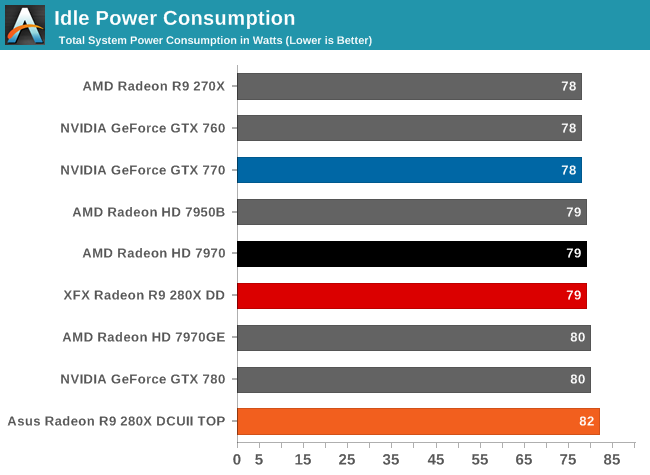
One of the advantages of our new testbed is that IVB-E and the testbed as a whole draw a lot less power under load and idle. This makes it easier to isolate video card power consumption from the rest of the system, giving us more meaningful results.
In this case though there are no surprises to be found with idle power consumption given just how similar all of these cards are while idling.
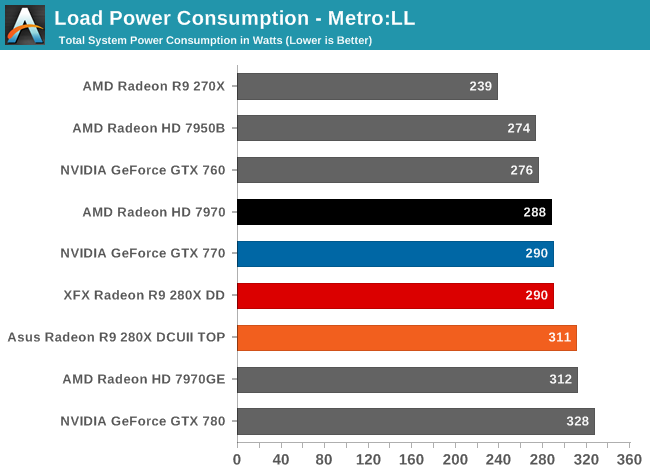
Up next is our new gaming power load test, for which we’re using Metro: Last Light. This was initially calibrated against a GTX 780, in which we found that Metro is both highly repeatable, runs long enough (when looped) to fully exercise a video card, and the load it puts on video cards as a percentage of allowable TDP is considerably average among all games.
To that end Metro paints an interesting picture of power consumption for the 280X. Despite its identical to the 7970GE TDP of 250W, real power consumption is down versus that card, and at least at the wall is identical to the 230W GTX 770 (not that NVIDIA and AMD measure TDP in the same way). What this tells us is that alongside their similar on average performance, the GTX 770 and 280X also draw similar amounts of power under gaming workloads.
Meanwhile Asus’s 280X draws more power, closer to a 7970GE, but this is not unexpected for a factory overclock.
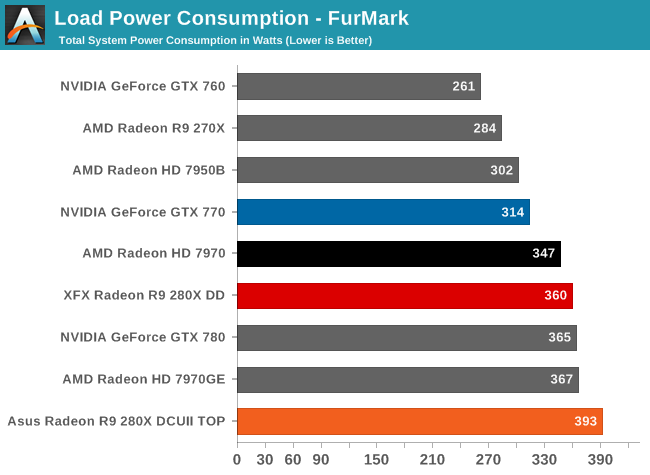
FurMark on the other hand, being the TDP buster that it is, paints a different picture of the situation. The 280X can generate and sustain a much higher power workload than the comparable GTX 770, and still more yet than the original 7970. FurMark isn’t a game and that’s why we primarily use it as a diagnostic tool as opposed to a real world test, but it does lend credit to the fact that when pushed to its limits 280X is still a high TDP part.
At the same time because FurMark is such a consistent TDP test, the outcome of this test leads us to believe that the Asus 280X isn’t just overclocked, but Asus has also increased their TDP/PowerTune limits to avoid bottlenecking there. The power consumption here is consistent with the XFX card having its PowerTune limit turned up, which implies that the Asus card is closer to a 300W card under maximum load. The gaming performance is very good as we’ve seen, but there is a cost.
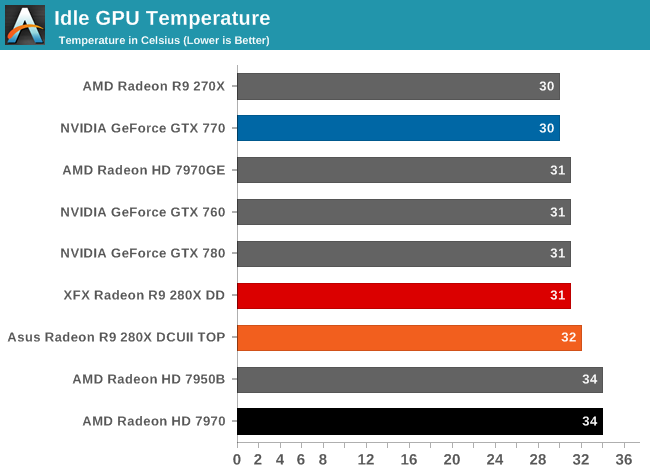
Like most open air coolers, our 280X cards do well enough here. 31C-32C is where most cards will idle at.
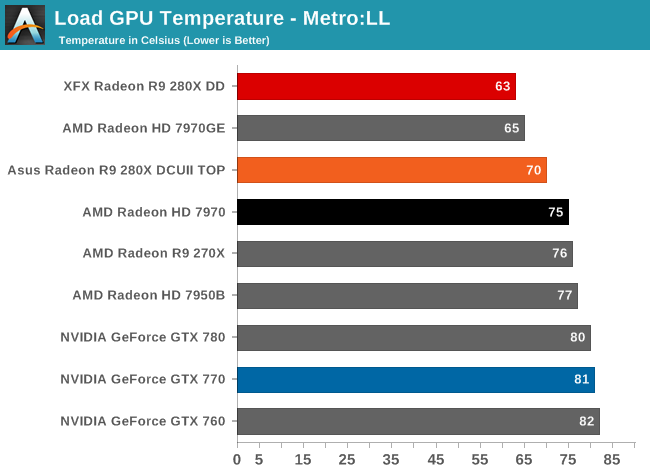
Of all of the Tahiti cards in this article, it’s our XFX 280X that delivers the best temperatures under load. 63 is downright chilly for a 250W card, indicating the card has plenty of thermal headroom. The Asus card by comparison doesn’t fare quite as well, but we don’t even bat an eye until we hit 80C.
It’s worth noting that both cards also do well against the GTX 700 series here, though this is entirely down to the use of open air coolers. As good as these coolers are you won’t be stuffing either card in a cramped case with limited ventilation; for that you need a blower.

As to be expected FurMark drives up our temperatures further. The XFX 280X is no longer our coolest card overall – that goes to the Tahiti based 7970GE – but of the two 280X cards it’s still the cooler one. The Asus meanwhile reaches 76C, which is still a reasonable temperature but it does mean the card doesn’t have a ton of thermal headroom left on its default fan curve. Though if our suspicions are right about the Asus card operating at a higher TDP, then this would at least explain in part the higher temperatures.
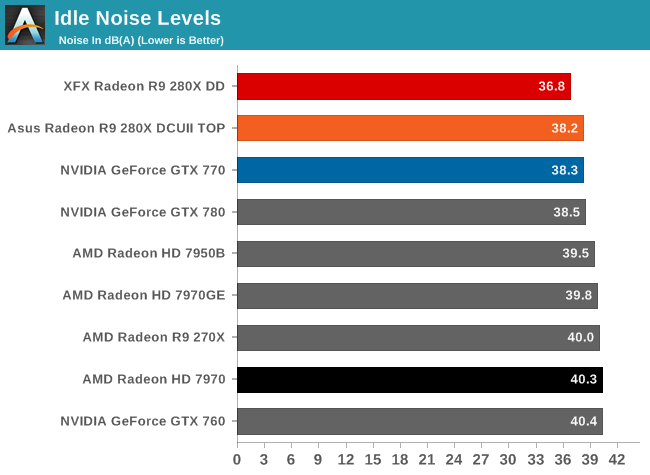
With this being the first article on our new testbed we re-ran the XFX result thrice to make sure we weren’t making any errors, but indeed these results are accurate. Whereas every other card dropped off at around 38dB the XFX 280X bested them with 36.8dB. Even among open air coolers this is a very impressive card at idle. In comparison the Asus is merely average in its near-silence.

Once we start looking at load noise levels however, the picture changes completely. As impressive as the XFX card was at idle, it doesn’t begin to compare to the Asus card under load. We have a card that’s channeling nearly 250W of heat out and away on a sustained basis, and yet for all of that work it generates just 41.5dB(A) of noise on our testbed. This is simply absurd in the most delightful fashion. Most of the cards in our data collection idle at just 2dB lower than this, never mind noise under load. As a result this is incredibly close to being functionally silent; in the case of our testbed the Asus card isn’t even the principle noise source when it’s under load.
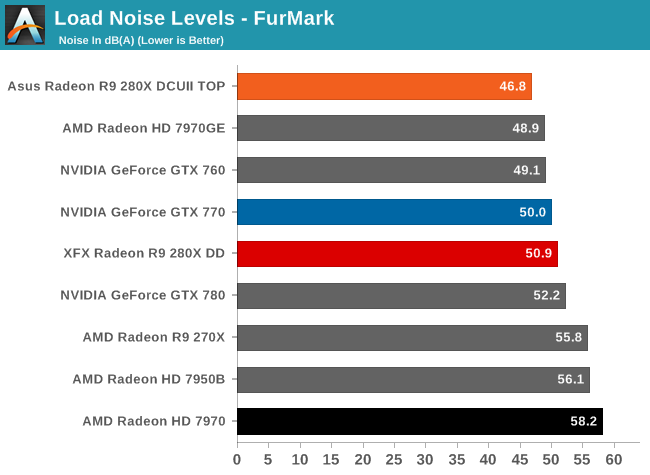
Last, but not least we have noise under FurMark. Although the Asus eventually has to ramp up and leave it’s low-40s comfort zone, at 46.8dB it’s still the quietest card around by 2dB(A). The XFX 280X meanwhile is merely average, if not a tinge worse for an open air cooler. 50.9dB(A) is plenty reasonable, it just pales in comparison to the Asus card.










151 Comments
View All Comments
Ryan Smith - Tuesday, October 8, 2013 - link
That's the first I've seen of that, so I can't really comment.But when I was discussing Mantle with AMD, they did discount using OpenGL. There was a specific desire to have a pure API that was completely free from legacy cruft (and there's nothing cruftier than OGL) while also being free to quickly evolve the project without having to involve the ARB.
konondrum - Tuesday, October 8, 2013 - link
Well this is one of the most disappointing products launches I've ever seen. At least the nVidia 700 series was more then a sticker change. This isn't even really a price drop as $300 7970s and $200 7870s (with game bundles) have been available for a while. Tell me AMD, why am I supposed to care? If these included TrueAudio at least that would be a differentiating feature, but there is seriously nothing new here at all.The only good thing I can say about this is that it makes me much more comfortable about my current 660ti 3gb. Looks like it will be strong though 2014 at least.
just4U - Tuesday, October 8, 2013 - link
I've yet to see a 7970 GHZ Ed. for under $360.. Hell until a month and a half ago you were lucky to get it under $400 on sale.just4U - Tuesday, October 8, 2013 - link
At any rate this may put some pressure on Nvidia for their 7x series.. I think it's going to be incentive for those still rocking it out on Amd's 6000 series or Nvidia 500 series and earlier to maybe upgrade.Personally I figure if you got a 570/80 or a 6950 (or better) the new stuff by both companies is a bit of a hard sell unless your playing at crazy resolutions... most still sit comfortably in 1080P or 1920/1200 resolution and the old standby 1600/1050.
matagyula - Tuesday, October 8, 2013 - link
I have been looking to replace my now 2 year old HD6870 with something a little beefier, and I was eagerly awaiting AMDs new product launch.But now I am left with even more questions than before - most importantly, should I upgade at all in the upcoming 8-12 months? The card is still putting in solid work, and while I have to settle for mid-high detail settings when it comes to titles like BF3 or Crysis 3, other games perform just fine /DotA 2 and CS:GO @ 1920*1200/.
At the 170-200eur price range I am looking at HD7870, or waiting a couple months for the HD7950 to drop bellow 200eur, while the HD7970 is still at 330eur in Slovakia.
The more I think about it the more I am inclined towards holding off for another year or so :|
ShieTar - Tuesday, October 8, 2013 - link
Stop buying locally. You can order a 7970 for ~240€ from Germany, and delivery to Slovakia should not cost more than ~15€ :http://www.heise.de/preisvergleich/eu/?cat=gra16_5...
Of course an Austrian or Polish shop may be even cheaper for some cards, if the postage is less than for a delivery from Germany. Or depending on where you live, maybe you just go and have a daytrip into either country and bring the card back home ;-)
just4U - Tuesday, October 8, 2013 - link
Well Matt, I sold my 6950 2G and really wanted a 670 or a 7950-70 as I figured that was a decent upgrade. I settled for the 7870 and noticed some ok gains. It's a tough call for you though..The 280X is going to give you 7970GHZ Ed like performance according to reviews.. but basically in the price range of a 7870. Tempting.. but you might get lucky with close out deals on the 7970 or even see price drops on the 770 from Nvidia. that are more attractive. All worthwhile upgrades over the 6870 but not night/day differences.. We really haven't seen a chip come out yet that raises the bar to a whole new level.
piroroadkill - Tuesday, October 8, 2013 - link
Wow. This is a boring card launch.The ASUS card itself is a good SKU, but absolutely nothing that could not have been done branded as 7970.
I understand they have a lot of old GPUs they want to re-use, so they don't want to re-tool them for the TrueAudio DSP, but it is downright stupid that they didn't at least add another small package to the card with the DSP in, so the new range can have feature parity.
AMD, your new card names are terrible, and this launch is pretty bland and watered down.
ninjaquick - Tuesday, October 8, 2013 - link
Well, that is inevitable. AMD's GCN design is not top-down, it is fully modular. IMC / ROP / ShaderClusters are all their own modules, each 'TMU' is attached to 16 'compute cores'. The entire point of the GCN design is that it scales up infinitely. This is why AMD is releasing Mantle. There is no reason to abandon the GCN design in the near future.It is not like AMD is releasing a brand new never seen before design that is the culmination of years of design work. The 290X is literally a 7970 with 12 more ROPs and an extra 128bit memory path which are only needed to accomodate the extra 48 rendering clusters. If you were to take the 7970 and add 48 clusters at the same clock speed you would get *exactly* the same perf as what the 290X delivers. Simple as that.
thylboy - Tuesday, October 8, 2013 - link
I saw on AMD´s homepage that these cards support their "Zero Core" technology. Can anyone confirm whether cards like this actually turn off the fans completely when in the long idle mode or not?